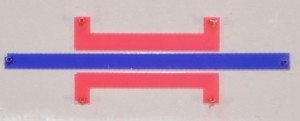Anil B. Shrirao1 and Raquel Perez-Castillejos1,2
1 Department of Electrical and Computer Engineering, 2 Department of Biomedical Engineering, New Jersey Institute of Technology, Newark NJ, USA
Why is this useful?
We present a method for fabricating PDMS microfluidic devices based on replicating a master made of Scotch tape. Often the fabrication of microfluidic devices by soft lithography is restricted to those who have access to a cleanroom that allows the fabrication of a master with micrometric features. Here we demonstrate that patterned Scotch tape can be used (without the need of any chemical treatment) as a master for soft lithography yielding microfluidic devices with a uniform height of ~ 60 µm. As a difference to previous Chips & Tips on rapid and easy prototyping techniques [1, 2], in this method the Scotch tape does not remain as part of the microfluidic device after fabrication. Here we used a handheld cutting tool (scalpel) to pattern the Scotch tape. A laser cutting machine could be used, instead, for masters requiring higher precision.
What do I need?
- Glass slides, pre-cleaned from Manufacturer (Fisher Scientific, 75mm x 50mm x 1mm, Cat. No. 12-550-C)
- Scotch tape (3M Scotch® Transparent Tape 600[6])
- Stainless steel Scalpel or surgical blade with (Feather Safety Razor Co., LTD, Cat. No. 2976#11)
- Polystyrene Petri dish (Fisher Scientific, 100mm x 15mm, Cat. No. 08-757-12)
- Tweezers
- Oven or hot plate (to work at 65°C)
- Gloves (do not use latex gloves)
- PDMS silicone elastomer base and curing agent (Sylgard 184, Dow Corning)
What do I do?
1. Attach a strip of Scotch tape to the glass slide. The thickness of the Scotch tape will determine the height of the microchannel. (To increase the height of the channel, attach additional strips of Scotch tape.)
2. Print the layout of the microchannel on regular paper. Place the printout on a flat surface.
3. Place the glass slide on the printout, with the Scotch tape facing up. Align the glass slide to the microchannel layout. Fix the glass slide to the printout with a piece of Scotch tape on the corner of the slide.
4. Use the scalpel to cut the tape on the glass slide according to the layout. (For cutting, we used another glass slide as a ruler)
5. Remove the Scotch tape from all regions of the glass slide except those in the layout of the microchannel.
6. Place the glass slide with patterned Scotch tape in a heating oven at 65°C for 2-3min; this improves the adhesion of the edges of patterned Scotch tape to the glass substrate. At this point, the Scotch-tape pattern does not need any further treatment in order to be used as a master for soft lithography [1].
7. Mix the base and curing components of PDMS as recommended by the manufacturer [2]. Place the glass slide in a Petri dish, with the patterned Scotch tape facing up. Pour the PDMS mixture in the Petri dish until the master (i.e., glass slide and Scotch tape) is covered completely. Degas PDMS in vacuum (if needed) and allow it to cure for 1 hour at 65°C.
8. Use the scalpel to cut the slab of PDMS containing the microchannel. Peel off the PDMS replica. (The Scotch-tape master can be used again by repeating step 7.)
9. Punch holes in the PDMS replica for the inlets and outlets of the microfluidic device.
10. Seal the PDMS replica to a substrate, either (i) conformally-by bringing the PDMS replica in contact with a smooth, clean substrate-or (ii) irreversibly-by bringing the PDMS replica in contact with the substrate after oxidizing both parts in an oxygen plasma [3]).
Acknowledgements
R. P.-C. acknowledges the support of the New Jersey institute of Technology through starting faculty funds.
References
[1] R. J. Holmes and N. J, Goddard, Rapid prototyping of microfluidics, Chips & Tips (Lab on a Chip), 15 February 2007.
[2] R, Kumar, R. L. Smith, and M. G. Pappas, A method for rapid fabrication of microfluidic devices, Chips & Tips (Lab on a Chip), 30 June 2009.
[3] Y. Xia and G. M. Whitesides, Annu. Rev. Sci., 1998, 28, 153-184.
[4] Dow Corning Product Information, “Information about Dow Corning® brand Silicone Encapsulants”.
[5] M. K. Chaudhury and G. M. Whitesides, Langmuir, 1991, 7, 1013-1025.
[6] Scotch tape

















